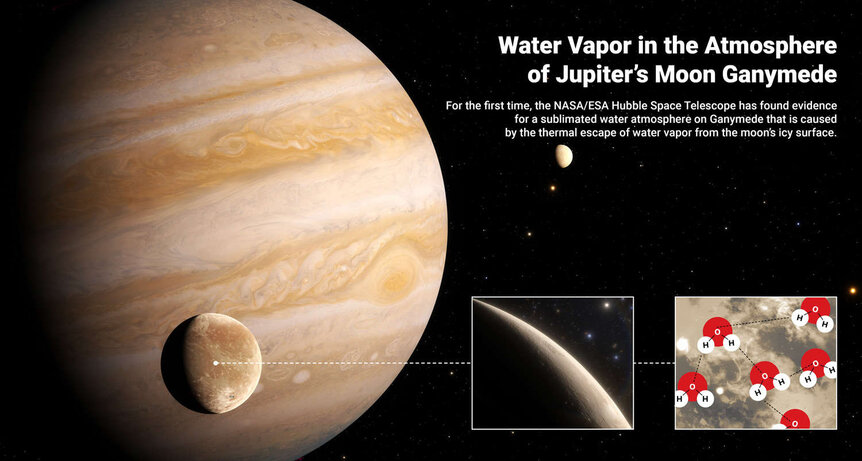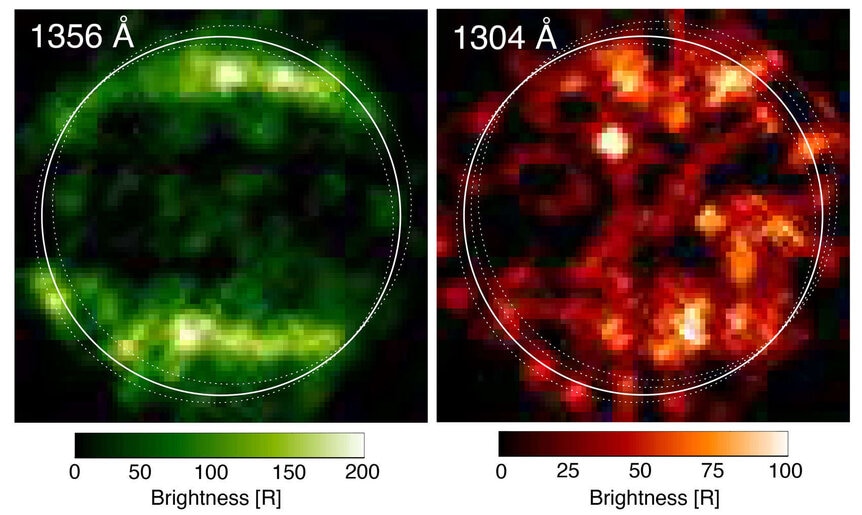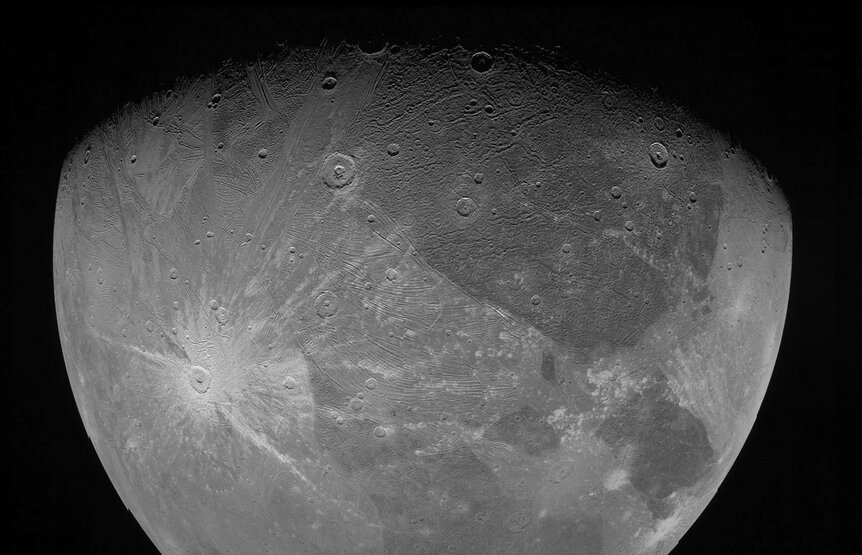Create a free profile to get unlimited access to exclusive videos, sweepstakes, and more!
Forecast for Jupiter's moon Ganymede: Extremely cold and… humid?

Using a combination of old and new data from Hubble Space Telescope, astronomers have found water vapor in the atmosphere of Jupiter’s planet-sized moon Ganymede!
This is very cool news, literally: On most of the moon it’s too cold for water vapor, but in some spots where it’s warmest they found the highest abundance of it, clearly indicating it’s coming from sunlight heating the surface. Plus, bizarrely, a contribution from Jupiter’s ridiculously fierce magnetic field.
Ganymede is the largest moon in the solar system, bigger than Mercury, and if it weren’t orbiting Jupiter it’d be considered a planet in its own right. In fact, it’s so big it’s differentiated, meaning it has heavy things like molten iron and nickel in its core, a layer of rock, and then between that and the surface a substantial liquid water ocean several hundred kilometers deep!
The surface is mostly rock and ice, and the crust very thick. It’s unlikely that any water from the undersurface ocean can get to the surface.
However, observations using the Space Telescope Imaging Spectrograph (or STIS) on Hubble in 1998* showed gaseous atomic oxygen glowing like an aurora over Ganymede’s surface. The moon has a weak magnetic field (generated by its iron core) that interacts with Jupiter’s overwhelmingly powerful one. This gives the atomic oxygen energy, causing it to glow.
But where did the oxygen come from? Models of the surface predicted the presence of water molecules as well, which would get slammed by subatomic particles accelerated by Jupiter’s magnetic field. That would break them apart, creating oxygen. But no water was detected.
So astronomers made new ultraviolet observations of Ganymede using the Cosmic Origins Spectrograph on board Hubble. They very carefully measured two different wavelengths (think of them as colors) of UV light, and found that the ratio of the brightness of the two requires that there be water vapor present; no other explanation is plausible.
So this is an indirect discovery but still a discovery! Mind you, the atmosphere is extraordinarily thin, just about a billion molecules per cubic centimeter. By comparison, the air you’re breathing is 10 billion times denser. Standing on Ganymede isn’t much different than standing in a vacuum.
Interestingly, the water vapor is most abundant on the surface on what’s called the subsolar point, where the Sun shines straight down (think of it as where it’s noon). That is the warmest part of the surface, so it’s clear the vapor is coming from sunlight warming the surface enough that water molecules can turn directly from ice to a gas, a process called sublimation. That makes this the very first and only detection so far of water vapor sublimated by sunlight from the ice of any moon in the outer solar system. Pretty cool.
One part of all this I found particularly nifty is that they found more water vapor on the trailing side of Ganymede than the leading side. Like all moons in the solar system, Ganymede spins once for every time it orbits Jupiter, keeping the same face toward it (like our Moon does with Earth). That’s no coincidence. But it also means that one hemisphere of the moon always faces into the direction it’s moving (like a car’s front windshield), called the leading hemisphere, and the other always faces away, so it’s the trailing hemisphere.
But. Ganymede takes a week to orbit Jupiter once while Jupiter spins once every 10 hours. That means Jupiter’s magnetic field rotates much faster than Ganymede orbits, so that in turn means the magnetic field sweeps over the moon’s trailing hemisphere. Again, lots of subatomic particles are caught in the field, so they slam into the surface on Ganymede’s backside. That changes the chemistry of the ice there, darkening it slightly, so it’s actually slightly warmer in sunlight, about -131° C (-204° F) versus -125° C (-193° F). It’s not much, but it does help create more water vapor on the trailing side than the leading one.
The water vapor only exists at the subsolar point, which changes over the course of Ganymede’s orbit; as you look farther from that point the amount drops precipitously. But when the subsolar point is on the trailing hemisphere there’s a lot more water vapor, by a factor of six times, because it’s slightly warmer. That’s amazing.
We’ve known about the existence of moons around Jupiter since at least the time of Galileo over 400 years ago. But we’re still learning about them, via computer models of the chemistry and physics tempered by observations taken on Earth and by spacecraft in orbit. In June of 2022 the European Space Agency plans to launch the Jupiter Icy moons Explorer, or JUICE (love that), which — after it arrives in 2030 — will orbit three of Jupiter’s moons including Ganymede. What will we find then? Especially at Europa, where the undersurface ocean may very well leak out onto the surface?
Stay tuned. That will be something wonderful.
*Full disclosure: From 1995-2000 I was on the team that built and calibrated STIS. That’s one reason I love writing about any observations using it!

















